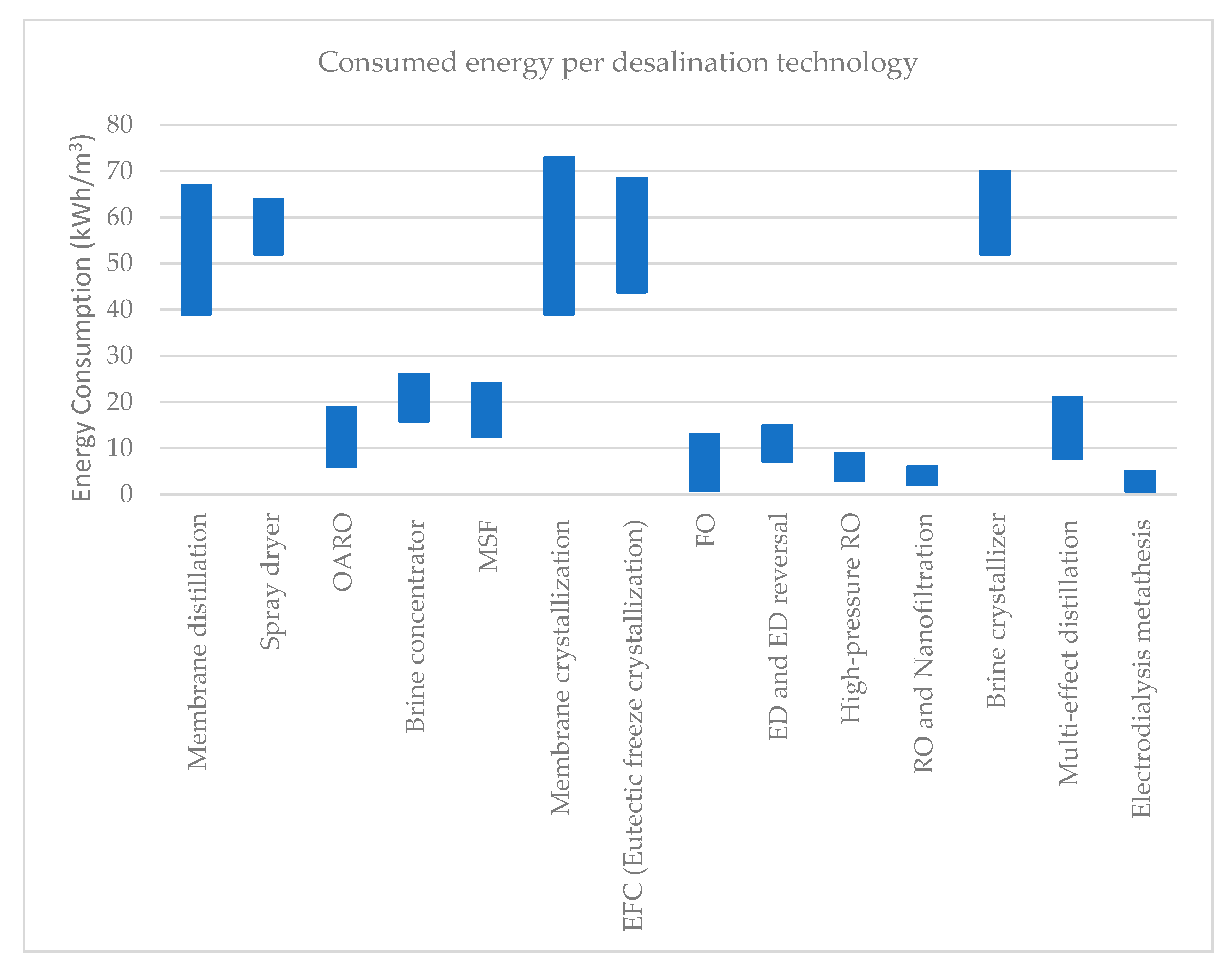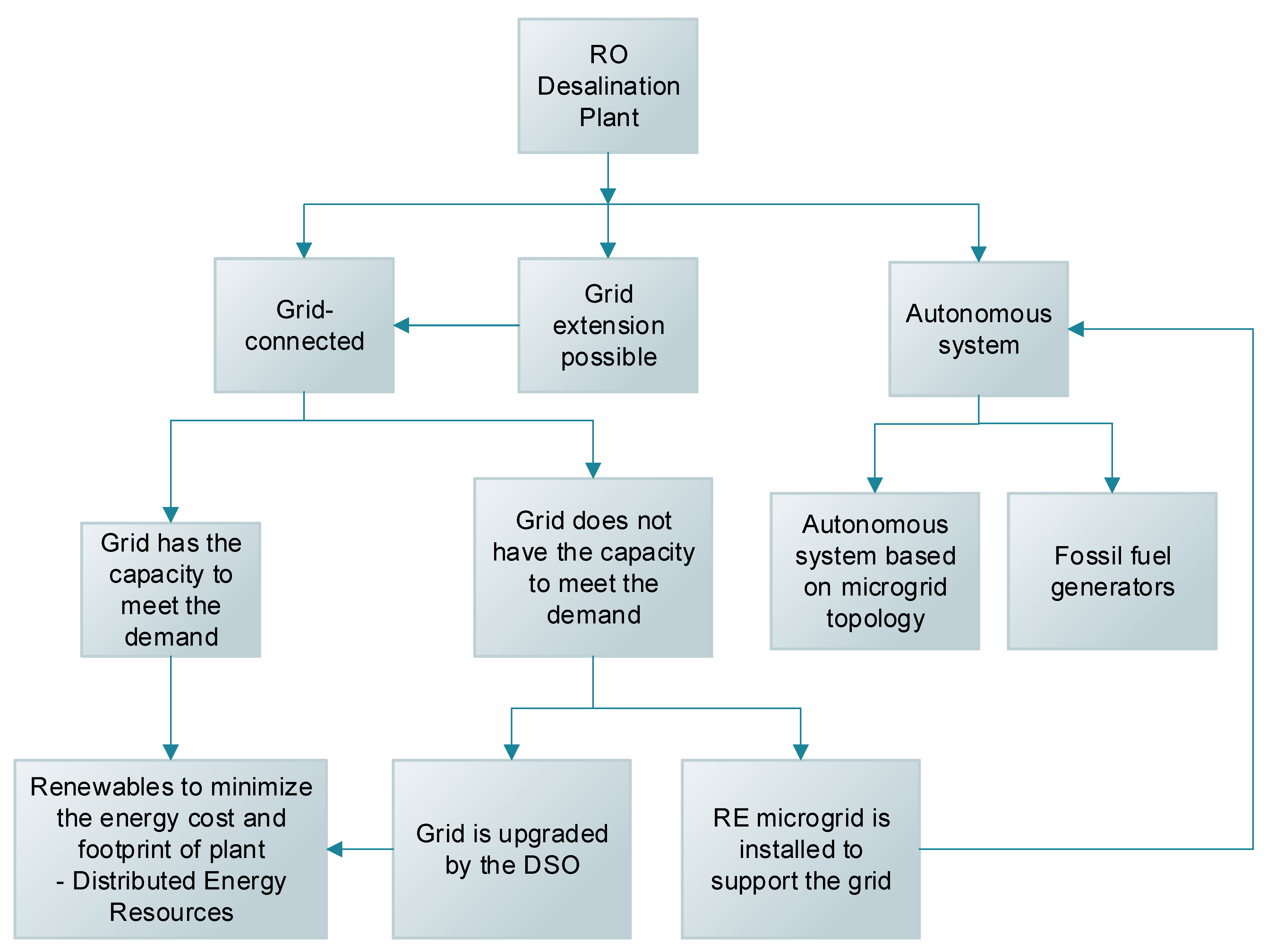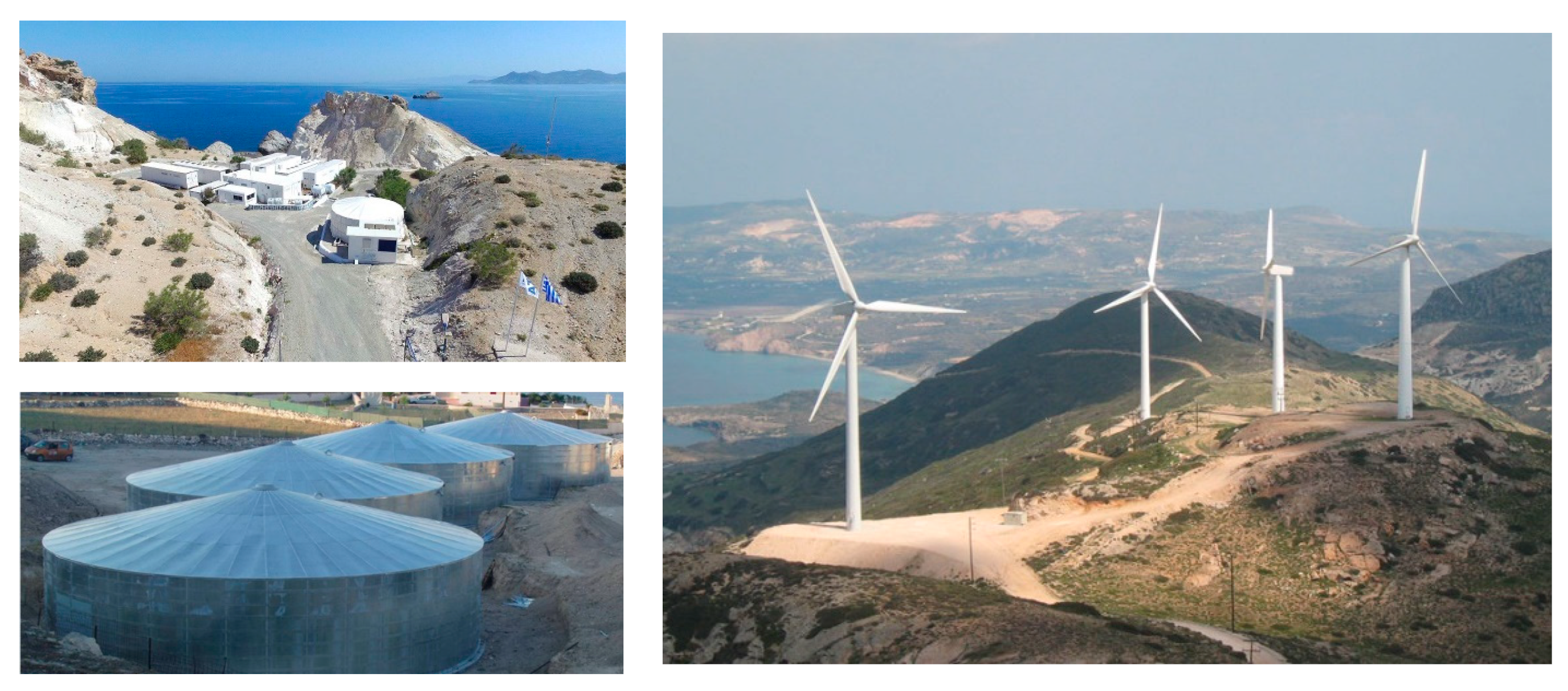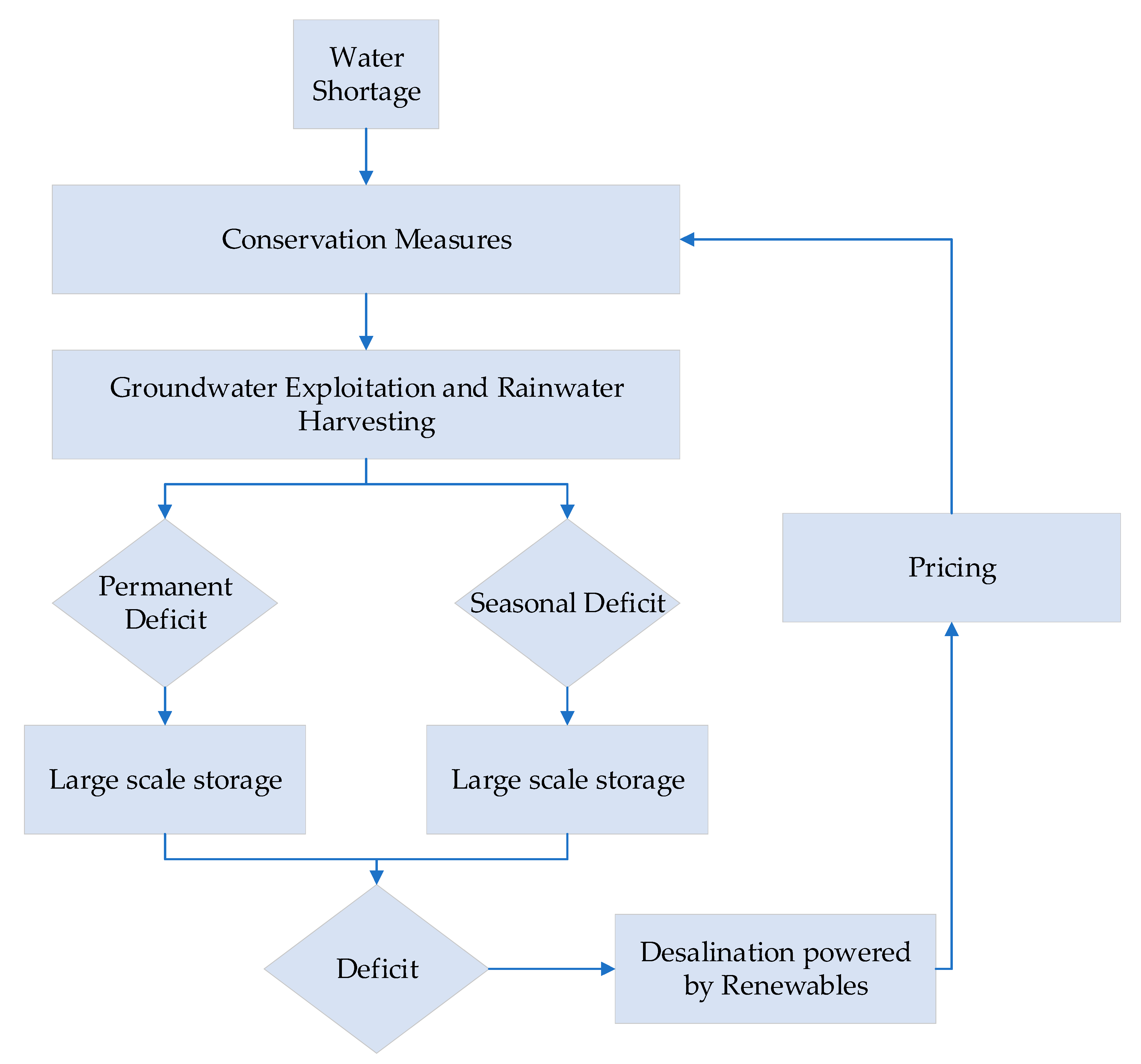Renewable Energy Desalination for Island Communities: Status and Future Prospects in Greece
Abstract
:1. Introduction
2. Materials and Methods
2.1. State of the Art of Desalination Systems Powered by Renewables
2.1.1. Desalination Technologies
2.1.2. Environmental Considerations for Desalination
- Release in waste water: Essentially, brine is mixed in waste water. This can decrease the growth of bacteria in waste water treatment plants. The cost of this method is between 0.32–0.66 USD/m3 brine.
- Evaporation pond: In this method, salt is gathered from the ponds after the water has evaporated. This can result in groundwater pollution and soil salinization. The cost of this method is between 3.28–10.04 USD/m3 Brine.
- Mixing with surface water: In this case, brine is mixed with surface waters. The main challenges of this method is that it can lead to marine environment pollution. The cost of this method is between 0.05–0.30 USD/m3 Brine.
- Discharging in deep wells: In this method, brine is discharged into porous subsurface rock layers. The main challenges associated with this method include groundwater pollution and soil salinization. The cost of this method is between 0.54–2.65 USD/m3 Brine.
- Releasing on land: The brine is used to irrigate tolerant to high salinity plants. This leads to soil salinization. The cost of this method is between 0.74–1.95 USD/m3 Brine.
- Intake/outflow to be located in higher depths and areas that are active biologically.
- Deployment of structures preventing the organisms from reaching the intake and discharge systems.
- Deployment of bypassing structures allowing blocked organisms to leave the intake/discharge systems.
- Reduce the flowrate of the feed water intake to 0.15 m/s which helps fish not to get trapped.
- Utilize velocity caps and other devices (e.g., ones that generate light and sound) to prevent organisms from approaching.
- Design the mesh size of the screen effectively to decrease entrainment, impingement, and entrapment.
- Install the inlet/outlet in an active zone with currents and waves.
- Proper design and installation of inlet/outlet wells.
- Reduction of the intake size.
- Use materials with superior corrosion/erosion performance.
- Effective maintenance program.
2.1.3. Powering Desalination
2.1.4. Renewable Energy and Desalination
- Use of renewable energy technologies as well as utilization waste heat. Currently, PV use is the most popular application.
- Co-generation can increase the desalination plant’s efficiency so long as electricity and thermal energy are simultaneously utilized [37]. Nevertheless, such co-generation schemes can only be applied to large scale desalination plants of several tens of thousands m3/day and they are not suitable to small scale plants of a few thousand of m3/day.
- Autonomous topology (no connection to the grid). The RO system is powered exclusively from the renewable energy system either (a) directly (without battery storage—for very small systems) or (b) through batteries.
- Semi-autonomous topology. In this mode the RO system may be powered from the renewables system (equipped with a battery storage) and any surplus of PV energy is supplied to the grid (or shredded if the grid cannot absorb it and the batteries are full). Any additional power required by the RO plant may be taken from the grid.
- Independent topology, where the renewable energy system is grid connected. In this mode, the power from the PV system is fed to the grid and the required power from the RO plant is drawn from the grid.
- Technological availability and suitability.
- Environmental/Land use.
- Economic issues.
- Location specific characteristics.
- Energy–RES availability and quality.
2.1.5. Cost of Desalinated Water
Large Scale Plants
- choice of technology.
- cost of energy.
- plant size and configuration.
- feed water and product water quality.
- environmental compliance requirements.
Small-Scale Plants
- Energy storage increases the cost of the system. The grid connected system with net-metering provides the cheapest water.
- Geothermal energy is, as expected, the renewable energy resource with the minimum cost even at low temperatures near 100 °C. Even in a fully autonomous scenario well, a minimum size battery bank needs to be included [46] and the cost is comparable with the grid connected PVs.
- Hybrid systems provide lower cost of water in comparison to either only PVs or only wind turbine systems. The wind potential of the area needs to be explored.
- Grid-connected PV-RO may be considered the most cost-effective option (in cases where the cost of land is low, which is not always the case in the Greek Aegean islands).
- If the same amount of water is to be produced by an RO plant which is operated by PV without grid backup, the cost rises. Notice that PV off-grid desalination without (or with minimal) electricity storage and RO operating at variable conditions have not yet become a commercial practice.
- Autonomous PV-ROs are expensive mainly because of the need of battery storage and the high cost associated to them.
- The benefits of using self-produced electricity are increasing as the cost of grid electricity is increasing. In Spring 2022, electricity cost in Europe has been increasing due to the situation caused by the conflict in the Ukraine.
2.2. Desalination in Greece
2.2.1. Water Needs in Greek Islands and Existing Water Supply Options
2.2.2. Desalination Systems in Greece
2.2.3. Powering Desalination in Greece
2.2.4. Strategies for Addressing Water Needs of Islands
3. Results and Discussion
- Constructing new off stream water storage infrastructure (tanks and reservoirs), combined with desalination plants, as well improvement of the operational efficiency of the existing reservoirs.
- Constructing new dams resulting in new water reservoirs.
- Constructing new desalination plants which has become more cost-effective due to the technological progress.
- Water hauling from other neighboring islands or from the mainland—this has to be considered only as a last resort option.
- Maintenance and upgrading of the island’s infrastructure in order to minimize water losses, e.g., extensive maintenance of faulty sections of the water supply networks, complete replacement of antiquated water supply systems, closed conduits water quality management, etc.
- RWH and storage in private or public water reservoirs, wherever this is possible.
- Constructing an additional water supply network in parallel for secondary uses able to utilize lower-quality water.
- Wastewater treatment and reuse for secondary uses.
- Utilization of demand management approaches (i.e., pricing policies, water conservation incentives, public participation and involvement, etc.).
4. Conclusions
Author Contributions
Funding
Institutional Review Board Statement
Informed Consent Statement
Acknowledgments
Conflicts of Interest
Abbreviations
| BWRO | Brackish Water Reverse Osmosis |
| CSP | Concentrated Solar Power (CSP) |
| DSO | Distribution System Operator |
| ED | Electrodialysis |
| EDR | Electrodialysis Reversal |
| ERD | Energy Recovery Devices |
| EU | European Union |
| FO | Forward Osmosis |
| GHGs | Green House Gases |
| mCDI | Membrane capacitive deionization |
| MED | Multi-Effect Distillation |
| MLD | Minimum Liquid Discharge |
| MSF | Multi-Stage Flash distillation |
| NF | Nanofiltration |
| OARO | Osmotically Assisted Reverse Osmosis |
| PVs | Photovoltaics |
| RES | Renewable Energy Sources |
| RO | Reverse Osmosis |
| RWH | Rainwater Harvesting (RWH) |
| SSD | Small-Scale Desalination |
| SWRO | Seawater Reverse Osmosis |
| TDS | Total Dissolved Solids |
| VCD | Vapor Compression Distillation |
| WACC | Weighted Average Cost of Capital (WACC) |
| ZLD | Zero Liquid Discharge |
References
- United Nations Children’s Fund (UNICEF) and World Health Organization. Progress on Household Drinking Water, Sanitation and Hygiene 2000–2017: Special Focus on Inequalities; United Nations Children’s Fund (UNICEF): New York, NY, USA; World Health Organization: Geneva, Switzerland, 2019.
- Hirabayashi, Y.; Kanae, S.; Emori, S.; Oki, T.; Kimoto, M. Global projections of changing risks of floods and droughts in a changing climate. Hydrol. Sci. J. 2008, 53, 754–772. [Google Scholar] [CrossRef]
- European Commission. The European Green Deal. In COM(2019) 640 Final; European Commission: Brussels, Belgium, 2019. [Google Scholar]
- Kyriakarakos, G.; Papadakis, G. Is Small Scale Desalination Coupled with Renewable Energy a Cost-Effective Solution? Appl. Sci. 2021, 11, 5419. [Google Scholar] [CrossRef]
- Beltrán, J.M.; Koo-Oshima, S. Water desalination for agricultural applications. FAO Land Water Discuss. Pap. 2006, 5, 48. [Google Scholar]
- Daghari, I.; Zarroug, E.; Ramadhane, M.; Muanda, C.; Kompany, J.R.; Kanzari, S.; Mimoun, A.B. Feasibility of water desalination for irrigation: The case of the coastal irrigated area of Dyiar-Al-Hujjej, Tunisia. Water Supply 2021, 21, 24–45. [Google Scholar] [CrossRef]
- Voutchkov, N. Desalination Engineering: Planning and Design; McGraw Hill Professional: New York, NY, USA, 2012. [Google Scholar]
- Wright, N.C.; Winter, A.G. Justification for community-scale photovoltaic-powered electrodialysis desalination systems for inland rural villages in India. Desalination 2014, 352, 82–91. [Google Scholar] [CrossRef]
- Boden, K.; Subban, C. A Road Map for Small-Scale Desalination: An Overview of Existing and Emerging Technology Solutions for Cost-Efficient and Low-Energy Desalination in South and Southeast Asia; Oxfam: Nairobi, Kenya, 2018. [Google Scholar] [CrossRef]
- Woo, Y.C.; Kim, S.-H.; Shon, H.K.; Tijing, L.D. Introduction: Membrane Desalination Today, Past, and Future. In Current Trends and Future Developments on (Bio-) Membranes; Basile, A., Curcio, E., Inamuddin, Eds.; Elsevier: Amsterdam, The Netherlands, 2019. [Google Scholar] [CrossRef]
- World Bank. The Role of Desalination in an Increasingly Water-Scarce World; World Bank: Washington, DC, USA, 2019. [Google Scholar]
- Voutchkov, N. Energy use for membrane seawater desalination–current status and trends. Desalination 2018, 431, 2–14. [Google Scholar] [CrossRef]
- Danfoss. Veolia Water Technologies and Danfoss Retrofit Municipal Water Plant to Save 57% in Energy. 2020. Available online: https://files.danfoss.com/download/HighPressurePumps/AE347548044753en-000101_02.2020_Veolia%20Water%20Technologies.pdf (accessed on 3 May 2022).
- Kim, J.; Park, K.; Yang, D.R.; Hong, S. A comprehensive review of energy consumption of seawater reverse osmosis desalination plants. Appl. Energy 2019, 254, 113652. [Google Scholar] [CrossRef]
- Koschikowski, J.; Jülch, V.; Kec, T.; Hussein, N.S. Renewable Desalination: Technology Options for Islands; IRENA: Abu Dhabi, United Arab Emirates, 2015. [Google Scholar]
- Missimer, T.M.; Maliva, R.G. Environmental issues in seawater reverse osmosis desalination: Intakes and outfalls. Desalination 2018, 434, 198–215. [Google Scholar] [CrossRef]
- Morillo, J.; Usero, J.; Rosado, D.; El Bakouri, H.; Riaza, A.; Bernaola, F.-J. Comparative study of brine management technologies for desalination plants. Desalination 2014, 336, 32–49. [Google Scholar] [CrossRef]
- Muhammad, Y.; Lee, W. Zero-liquid discharge (ZLD) technology for resource recovery from wastewater: A review. Sci. Total Environ. 2019, 681, 551–563. [Google Scholar] [CrossRef]
- Wang, Z.; Deshmukh, A.; Du, Y.; Elimelech, M. Minimal and zero liquid discharge with reverse osmosis using low-salt-rejection membranes. Water Res. 2020, 170, 115317. [Google Scholar] [CrossRef]
- Nakagawa, K.; Togo, N.; Takagi, R.; Shintani, T.; Yoshioka, T.; Kamio, E.; Matsuyama, H. Multistage osmotically assisted reverse osmosis process for concentrating solutions using hollow fiber membrane modules. Chem. Eng. Res. Des. 2020, 162, 117–124. [Google Scholar] [CrossRef]
- Panagopoulos, A.; Haralambous, K.-J.; Loizidou, M. Desalination brine disposal methods and treatment technologies—A review. Sci. Total Environ. 2019, 693, 133545. [Google Scholar] [CrossRef]
- Zeng, H.; Zhang, Y.; Zhang, L.; Chen, Z.; Li, X. Study on Hydrate Production Behaviors by Depressurization Combined with Brine Injection in the Excess-Water Hydrate Reservoir. Entropy 2022, 24, 765. [Google Scholar] [CrossRef]
- Panagopoulos, A. A comparative study on minimum and actual energy consumption for the treatment of desalination brine. Energy 2020, 212, 118733. [Google Scholar] [CrossRef]
- Levitt, J. Water, Radiation, Salt, and Other Stresses; Elsevier: Amsterdam, The Netherlands, 2015; Volume 2. [Google Scholar]
- Williams, R.G.; Follows, M.J. Ocean Dynamics and the Carbon Cycle: Principles and Mechanisms; Cambridge University Press: Cambridge, UK, 2011. [Google Scholar]
- Missimer, T.M.; Jones, B.; Maliva, R.G. Intakes and Outfalls for Seawater Reverse-Osmosis Desalination Facilities: Innovations and Environmental Impacts; Springer: Berlin/Heidelberg, Germany, 2015. [Google Scholar]
- Shrivastava, I.; Adams, E.E. Pre-dilution of desalination reject brine: Impact on outfall dilution in different water depths. J. Hydro-Environ. Res. 2019, 24, 28–35. [Google Scholar] [CrossRef]
- Abessi, O.; Roberts, P.J. Multiport diffusers for dense discharge in flowing ambient water. J. Hydraul. Eng. 2017, 143, 04017003. [Google Scholar] [CrossRef]
- Kress, N. Marine Impacts of Seawater Desalination: Science, Management, and Policy; Elsevier: Amsterdam, The Netherlands, 2019. [Google Scholar]
- IRENA. Renewable Power Generation Costs in 2020; IRENA: Abu Dhabi, United Arab Emirates, 2021. [Google Scholar]
- Al-Karaghouli, A.; Kazmerski, L.L. Energy consumption and water production cost of conventional and renewable-energy-powered desalination processes. Renew. Sustain. Energy Rev. 2013, 24, 343–356. [Google Scholar] [CrossRef]
- Jones, E.; Qadir, M.; van Vliet, M.T.H.; Smakhtin, V.; Kang, S.-m. The state of desalination and brine production: A global outlook. Sci. Total Environ. 2019, 657, 1343–1356. [Google Scholar] [CrossRef]
- Zarzo, D.; Prats, D. Desalination and energy consumption. What can we expect in the near future? Desalination 2018, 427, 1–9. [Google Scholar] [CrossRef]
- Mohammadi, F.; Sahraei-Ardakani, M.; Al-Abdullah, Y.; Heydt, G.T. Cost-Benefit Analysis of Desalination: A Power Market Opportunity. Electr. Power Compon. Syst. 2020, 48, 1091–1101. [Google Scholar] [CrossRef]
- Nassrullah, H.; Anis, S.F.; Hashaikeh, R.; Hilal, N. Energy for desalination: A state-of-the-art review. Desalination 2020, 491, 114569. [Google Scholar] [CrossRef]
- Panagopoulos, A.; Haralambous, K.-J. Environmental impacts of desalination and brine treatment—Challenges and mitigation measures. Mar. Pollut. Bull. 2020, 161, 111773. [Google Scholar] [CrossRef] [PubMed]
- Altmann, T.; Robert, J.; Bouma, A.; Swaminathan, J.; Lienhard, J.H. Primary energy and exergy of desalination technologies in a power-water cogeneration scheme. Appl. Energy 2019, 252, 113319. [Google Scholar] [CrossRef]
- El-Bialy, E.; Shalaby, S.; Kabeel, A.; Fathy, A. Cost analysis for several solar desalination systems. Desalination 2016, 384, 12–30. [Google Scholar] [CrossRef]
- Panchenko, V.; Izmailov, A.; Kharchenko, V.; Lobachevskiy, Y. Photovoltaic solar modules of different types and designs for energy supply. In Research Anthology on Clean Energy Management and Solutions; IGI Global: Hershey, PA, USA, 2021; pp. 731–752. [Google Scholar]
- Qiblawey, H.M.; Banat, F. Solar thermal desalination technologies. Desalination 2008, 220, 633–644. [Google Scholar] [CrossRef]
- Lienhard, J.H.; Thiel, G.P.; Warsinger, D.M.; Banchik, L.D. Low Carbon Desalination: Status and Research, Development, and Demonstration Needs, Report of a Workshop Conducted at the Massachusetts Institute of Technology in Association with the Global Clean Water Desalination Alliance; MIT Abdul Latif Jameel World Water and Food Security Lab: Cambridge, MA, USA, 2016. [Google Scholar]
- Kondili, E.; Kaldellis, J.K.; Paidousi, M. A multicriteria analysis for the optimal desalination–RES system. Special focus: The small Greek islands. Desalination Water Treat. 2013, 51, 1205–1218. [Google Scholar] [CrossRef]
- Kaya, A.; Tok, M.E.; Koc, M. A Levelized Cost Analysis for Solar-Energy-Powered Sea Water Desalination in the Emirate of Abu Dhabi. Sustainability 2019, 11, 1691. [Google Scholar] [CrossRef] [Green Version]
- Kesieme, U.K.; Milne, N.; Aral, H.; Cheng, C.Y.; Duke, M. Economic analysis of desalination technologies in the context of carbon pricing, and opportunities for membrane distillation. Desalination 2013, 323, 66–74. [Google Scholar] [CrossRef] [Green Version]
- Khan, M.A.M.; Rehman, S.; Al-Sulaiman, F.A. A hybrid renewable energy system as a potential energy source for water desalination using reverse osmosis: A review. Renew. Sustain. Energy Rev. 2018, 97, 456–477. [Google Scholar] [CrossRef]
- Kyriakarakos, G.; Ntavou, E.; Manolakos, D. Investigation of the Use of Low Temperature Geothermal Organic Rankine Cycle Engine in an Autonomous Polygeneration Microgrid. Sustainability 2020, 12, 10475. [Google Scholar] [CrossRef]
- Karavitis, C.A.; Kerkides, P. Estimation of the water resources potential in the island system of the Aegean Archipelago, Greece. Water Int. 2002, 27, 243–254. [Google Scholar] [CrossRef]
- Voivontas, D.; Arampatzis, G.; Manoli, E.; Karavitis, C.; Assimacopoulos, D. Water supply modeling towards sustainable environmental management in small islands: The case of Paros, Greece. Desalination 2003, 156, 127–135. [Google Scholar] [CrossRef]
- Assimacopoulos, D. Innovation and sustainable management of water resources: The new paradigms in small islands. In 100% RES—A Challenge for Island Sustainable Development; Marin, C., Alves, L., Zervos, A., Eds.; Unesco Center of the Canary Islands: Tenerife, Spain, 2005; Volume 100. [Google Scholar]
- Kourtis, I.M.; Kotsifakis, K.G.; Feloni, E.G.; Baltas, E.A. Sustainable water resources management in small Greek islands under changing climate. Water 2019, 11, 1694. [Google Scholar] [CrossRef] [Green Version]
- Karavitis, C.A.; Skondras, N.A.; Manoli, E.; Assimacopoulos, D. Assessing alternative water resources management scenarios in islands of the Aegean Archipelago, Greece. Glob. Nest J. 2012, 14, 264–275. [Google Scholar] [CrossRef]
- Papadakis, G.; Karavas, C. Desalination in Greece with or without renewable energy. In Proceedings of the Energy and Water, Athens, Greece, 29 November 2019. [Google Scholar]
- Londra, P.A.; Theocharis, A.T.; Baltas, E.; Tsihrintzis, V.A. Optimal Sizing of Rainwater Harvesting Tanks for Domestic Use in Greece. Water Resour. Manag. 2015, 29, 4357–4377. [Google Scholar] [CrossRef]
- Devkota, J.; Schlachter, H.; Apul, D. Life cycle based evaluation of harvested rainwater use in toilets and for irrigation. J. Clean. Prod. 2015, 95, 311–321. [Google Scholar] [CrossRef]
- Zotalis, K.; Dialynas, E.G.; Mamassis, N.; Angelakis, A.N. Desalination Technologies: Hellenic Experience. Water 2014, 6, 1134–1150. [Google Scholar] [CrossRef] [Green Version]
- Kartalidis, A.; Tzen, E.; Kampragkou, E.; Assimacopoulos, D. Responding to water challenges in Greece through desalination: Energy considerations. Int. J. Water Resour. Dev. 2016, 32, 428–441. [Google Scholar] [CrossRef]
- Kaldellis, J.K.; Gkikaki, A.; Kaldelli, E.; Kapsali, M. Investigating the energy autonomy of very small non-interconnected islands: A case study: Agathonisi, Greece. Energy Sustain. Dev. 2012, 16, 476–485. [Google Scholar] [CrossRef]
- Tzanes, G.; Zafeiraki, E.; Papapostolou, C.; Zafirakis, D.; Konstantinos, M.; Kavadias, K.; Chalvatzis, K.; Kaldellis, J.K. Assessing the Status of Electricity Generation in the Non-Interconnected Islands of the Aegean Sea Region. Energy Procedia 2019, 159, 424–429. [Google Scholar] [CrossRef]
- Katsoulakos, N.M. An Overview of the Greek Islands Autonomous Electrical Systems: Proposals for a Sustainable Energy Future. Smart Grid Renew. Energy 2019, 10, 28. [Google Scholar] [CrossRef] [Green Version]
- Official Government Gazzette. Approval of the Consideration to Cover Costs of Providing Services of General Interest, Official Government Gazette; Official Government Gazzette: Athens, Greece, 2014; Volume B, pp. 23627–23640.
- Hophmayer Tokich, S.; Hophmayer-Tokich, S.; Kadiman, T. Water Management on Islands–Common Issues and Possible Actions: A Concept Paper in Preparation to the International Workshop:“Capacity Building in Water Management for Sustainable Tourism on Islands”; CSTM-Reeks; Center for Clean Technology and Environmental Policy: Enschede, The Netherlands, 2006. [Google Scholar]
- Cánovas Cuenca, J. Report on Water Desalination Status in the Mediterranean Countries; Instituto Murciano de Investigación y Desarrollo Agrario y Alimentario, Consejería de Agricultura y Agua de la Región de Murcia: Murcia, Spain, 2012. [Google Scholar]
- Zheng, A.; Cao, Z.; Xu, Y.; Chen, H.; Deng, J. Analysis of hybrid Adiabatic Compressed Air Energy Storage-Reverse Osmosis desalination system with different topological structures. Desalination 2022, 530, 115667. [Google Scholar] [CrossRef]
- Cao, Z.; Deng, J.; Ye, F.; Garris, C.A., Jr. Analysis of a hybrid Thermal Vapor Compression and Reverse Osmosis desalination system at variable design conditions. Desalination 2018, 438, 54–62. [Google Scholar] [CrossRef]
- Kyriakarakos, G.; Dounis, A.I.; Arvanitis, K.G.; Papadakis, G. Design of a Fuzzy Cognitive Maps variable-load energy management system for autonomous PV-reverse osmosis desalination systems: A simulation survey. Appl. Energy 2017, 187, 575–584. [Google Scholar] [CrossRef]





| Cost Component | Data from [35] | Data from [11] |
|---|---|---|
| Electricity | 46.6% | 41% |
| Chemicals | 16.8% | 11% |
| Labour | 24.4% | 13% |
| Replacements | 12.2% | |
| Maintenance | 14% | |
| Membranes | 5% | |
| Other (Water discharge, Monitoring, Indirect costs) | 17% |
| Type of Interconnection | RE Technology Used | Net Present Cost (EUR/m3 of Water) |
|---|---|---|
| Grid-connected | No RE | 0.69 |
| Grid-connected/Net-metering | PV | 0.51 |
| Autonomous | PV—Batteries | 0.96 |
| Autonomous | Wind turbine—Batteries | 1.12 |
| Autonomous | PV-Wind turbine—Batteries hybrid | 0.78 |
| Autonomous | Geothermal ORC—Batteries | 0.52 |
| Location | Desalination Method | Renewable Energy Type | Comments |
|---|---|---|---|
| Syme island | VCD 450 m3/day | 750 kW wind turbine | Demo system. Installed in 2009 but stopped operating in 2013 |
| Kimolos island | MED 80 m3/day | Geothermal low enthalpy ~61 °C | Installed in 2000 in the framework of an EU project and stopped operating after the end of the project |
| Keratea, Attica | RO 3 m3/day | Hybrid PV 4 kWp and wind turbine 900 W | Demo PV-wind-RO system, still in operation |
| Melos island | RO 3360 m3/day | Wind turbine 600 kW | Installed in 2007. In operation |
| Herakleia island | RO 80 m3/day | Floating wind turbine 30 kW and a small PV system | Demo system. Installed in 2007. Not in operation |
| Strogyle island | RO 0.85 m3/h | PV 10 kW | Installed in 2014. In operation |
| Place | Cost (EUR/MWh) 2012 | Cost (EUR/MWh) 2021 |
|---|---|---|
| Agathonisi | 733.99 | 723.80 |
| Agios Eustratios | 444.00 | 486.34 |
| Amorgos | 410.37 | 436.80 |
| Anafe | 480.60 | 612.66 |
| Antikythera | 1748.07 | 1343.68 |
| Arkioi | 893.90 | 1479.76 |
| Astypalaia | 424.15 | 476.08 |
| Donousa | 766.92 | 1178.32 |
| Ereikousa | 878.13 | 783.08 |
| Thera | 204.88 | 192.37 |
| Ikaria | 363.70 | 447.75 |
| Megiste | 492.94 | 458.12 |
| Melos | 263.11 | Interconnected with mainland. |
| Mykonos | 360.54 | |
| Paros | 188.22 | |
| Sifnos | 381.45 | 476.38 |
Publisher’s Note: MDPI stays neutral with regard to jurisdictional claims in published maps and institutional affiliations. |
© 2022 by the authors. Licensee MDPI, Basel, Switzerland. This article is an open access article distributed under the terms and conditions of the Creative Commons Attribution (CC BY) license (https://creativecommons.org/licenses/by/4.0/).
Share and Cite
Kyriakarakos, G.; Papadakis, G.; Karavitis, C.A. Renewable Energy Desalination for Island Communities: Status and Future Prospects in Greece. Sustainability 2022, 14, 8176. https://doi.org/10.3390/su14138176
Kyriakarakos G, Papadakis G, Karavitis CA. Renewable Energy Desalination for Island Communities: Status and Future Prospects in Greece. Sustainability. 2022; 14(13):8176. https://doi.org/10.3390/su14138176
Chicago/Turabian StyleKyriakarakos, George, George Papadakis, and Christos A. Karavitis. 2022. "Renewable Energy Desalination for Island Communities: Status and Future Prospects in Greece" Sustainability 14, no. 13: 8176. https://doi.org/10.3390/su14138176






